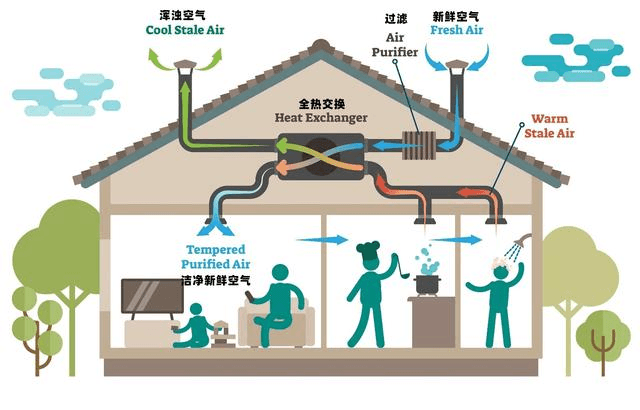
The following are some of the main functions and functions of the fresh air system:
1. Ventilation: The main function of the fresh air system is ventilation, ensuring continuous exchange of indoor and outdoor air. This helps to remove pollutants, odors, and moisture from the indoor environment, maintaining a healthy and comfortable environment.
2. Air purification: The filter element of the fresh air system can remove dust, allergens, and other particulate matter from the air. This helps to reduce pollutants from respiratory allergies, thereby improving indoor air quality.
3. Temperature and humidity control: The fresh air system with heat recovery (total heat exchange) can also help regulate the temperature and humidity levels inside the building. In warm weather, introducing colder outdoor air can help reduce indoor temperature, while in cold weather, the incoming air can be preheated to maintain a comfortable indoor environment.
4. Improving energy efficiency: A fresh air system with heat recovery (total heat exchange) can transfer heat from the discharged air to the incoming air in winter, helping to reduce heating costs and also lowering cooling costs in summer.
5. Indoor pollutant control: The fresh air system helps to dilute and remove indoor pollutants such as volatile organic compounds (VOCs), formaldehyde, or exhaust gases generated by building materials or furniture. By continuously introducing fresh air, these systems can help maintain a healthier indoor environment.
Which is better, one-way flow or two-way flow fresh air fan?
The choice between one-way flow and two-way flow fresh air fans depends on the specific requirements of the space, and each type has its own advantages and precautions.
The fresh air system optimizes indoor air quality, allowing building users to experience a healthy and comfortable air environment. The main function of the fresh air system is to continuously provide filtered fresh air to replace the old polluted air in buildings or spaces.

Here is a comparison:
Unidirectional flow fresh air fan: It introduces fresh air into the space, effectively removing pollutants and odors, and is usually used in spaces that require maintaining positive pressure. An additional exhaust system is required to achieve appropriate air balance. Due to the need for a separate exhaust system, energy consumption is high.
Bidirectional flow fresh air fan: introduces fresh air into the space and exhausts old air through the same device. They are commonly used in residential and commercial buildings to provide ventilation systems that balance temperature and humidity. Balanced ventilation is achieved through continuous air exchange. It can recover heat or cold from the discharged air, improving energy efficiency. Usually more cost-effective than unidirectional flow devices.

JODIE MO
Hello, I am Jodie Mo, the brand founder of Hunan LantisAir Environmental Protection Technology Co., Ltd. I have been running a ventilation equipment factory in China for 10 years. The purpose of this article is to share with you from the perspective of a Chinese supplier. Relevant knowledge of Fresh air systems.